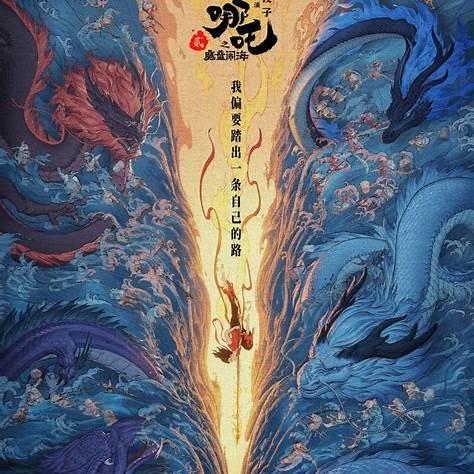When “Nezha: The Demon Child’s Rebellion in the Sea” was released on January 29, 2025, it was no longer merely a sequel to the 2019 hit film “Nezha: The Demon Child”, but a milestone event in China’s animation industry. This film is highly anticipated and is expected to make further breakthroughs in technology, culture and business. The box office performance of the film after its release and the intense discussions on social media platforms both at home and abroad indicate that it is not only worthy of praise but also requires critical reflection on its significance for the future of Chinese animation.
Plot and Theme
The film continues the rebellious yet endearing protagonist Nezha from the previous work. This time, it delves into the imagery of the ocean, showcasing his confrontation with inner demons and external forces. The core issues remain identity, destiny and self-choice, and are superimposed with themes of friendship, loyalty and collective responsibility. As Dyer (1993) pointed out, reproduction has never been neutral; Mythological characters like Nezha are constantly being rewritten to reflect the changes in their current cultural identities. The film’s narrative swings between the touching character arcs and the formulaic commercial narrative. Nezha’s personal struggle remains convincing, but the insufficient portrayal of supporting characters makes the overall ensemble image unbalanced.
Visual and technological achievements
In terms of technology, the film can be regarded as a breakthrough. Especially the animated representation of water demonstrates the progress of Chinese animation in fluid special effects, which is on par with Hollywood blockbusters such as “Moana” or “Avatar: The Way of Water”. The large-scale underwater battle scenes and the elaborately rendered environment and creatures are visually stunning. Many users on Douban and Bilibili shared the GIF of the video, praising its visual effects wonders.
However, as McDonald (2023) pointed out, the global animation industry often tends to prioritize creating spectacles while neglecting the clarity of narrative, and “Nezha 2” sometimes falls into this trap. Although the lengthy action scenes are spectacular, they slow down the development of the story. This reliance on wonders reveals that Chinese animation is eager to prove that it is on par with the West in terms of technology, but at the cost of sacrificing the compactness of narrative.

Cultural resonance
The most distinctive achievement of the film lies in its contemporary expression of traditional myths. The story of Nezha has been passed down in China for hundreds of years, but the film reinterprets it with a modern touch: rebellious youthful charm, complex family relationships, and even an implicit criticism of social expectations. For young audiences, Nezha is not only a mythological hero but also a contemporary teenager who can evoke resonance.
Meanwhile, this film reflects the growing cultural confidence of China’s creative industry. Lent (2021) pointed out that Asian popular culture is increasingly achieving cross-cultural communication by integrating traditional and global aesthetics, and “Nezha 2” is a typical example of this hybrid model. However, this transformation also carries risks: over-reliance on national cultural symbols may make it difficult for international audiences to fully understand the metaphors within them, thereby limiting global reach.
Market and industrial impact
On the commercial front, “Nezha 2” performed astonishingly well, breaking the box office record for January in China (Sun, 2025) and quickly ranking among the top box office films in Chinese cinema history. In a short period of time, Weibo and Douyin were flooded with viewers’ reactions, emojis and discussions.
From an industrial perspective, the film marks the enhancement of China’s animation competitiveness. High-quality production and international marketing not only demonstrate the ambition of domestic animation in the domestic market, but also show the intention to challenge international giants such as Disney, Pixar and DreamWorks. But the question is, can Chinese animation break away from mythological themes and expand into more diverse genres and narratives?
Audience and Digital Communication
The audience’s response further attests to the film’s cultural influence. Zhang (2025) found that discussions on Weibo about “Nezha 2” range from enthusiastic praise for the film to criticism of its narrative depth. For some people, this film is a symbol of the rise of Chinese animation. For some others, it still relies too much on the traditional mythological framework. This duality highlights that the film is both an entertainment product and a arena for cultural debate.
Advantages
The visual effects have made breakthroughs, especially in the rendering of underwater environments.
The character of Nezha has a distinct arc, combining mythological quality with a modern feel.
Cultural symbols have aroused strong resonance within the country.
It demonstrates the maturity of the domestic animation industry.
Disadvantage
Rhythm issue: Some action scenes are too long.
The supporting roles are poorly portrayed and the development of the group characters is unbalanced.
Excessive reliance on myths may limit international dissemination.
Occasionally, spectacle replaces narrative logic.
Conclusion
“Nezha: The Demon Child’s Rebellion in the Sea” is not merely a film; it is also a cultural declaration. It showcases the technical strength of Chinese animation, confirms the cultural vitality of myth recreation, and highlights China’s competitive ambition on the global animation stage. However, its narrative flaws remind us that visual innovation itself cannot replace a solid story.
For Chinese audiences, this film has strengthened cultural pride. For international audiences, it is both a dazzling audio-visual feast and an invitation to come into contact with Chinese mythology. Ultimately, “Nezha 2” is both a successful commercial blockbuster and a cultural experiment, although it occasionally seems inadequate due to its “excessive ambition”.
Reference
Dyer, R. (1993). The matter of images: Essays on representation. Routledge.
Lent, J. A. (2021). Asian popular culture: New, hybrid, and transnational. Rowman & Littlefield.
McDonald, P. (2023). Spectacle and narrative in global animation industries. Animation Studies, 18(2), 45–62.
Sun, Y. (2025, February 2). ‘Ne Zha 2’ breaks January box office records in China. The Hollywood Reporter. https://www.hollywoodreporter.com
Zhang, W. (2025). Digital audiences and fan engagement: Weibo discussions on Ne Zha 2. Journal of Chinese Media Studies, 12(1), 88–105.
